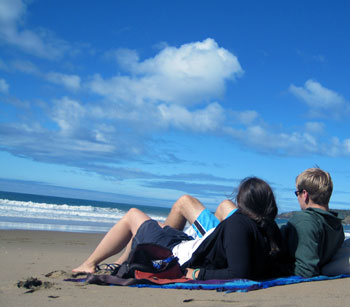THE Great Barrier Reef
Add Summary

Blogger: Abigail Lynch, a doctoral candidate in the Department of Fisheries and Wildlife and a CSIS member, blogs from Down Under -- she's in Australia to build a framework for her dissertation research. She's interested in developing a decision-support tool to regulate harvest management strategies for lake whitefish in a changing climate.
THE Great Barrier Reef
July 18, 2011
 For a marine biologist, anyone who aspired to be a marine biologist, or anyone who just enjoys visiting aquariums, the Great Barrier Reef is a life-long dream. As the largest structure created by living creatures (corals), the reef is yet another of Queensland’s world heritage sites. More than 1,600 miles long, it can be seen from space and is more than 200 miles LONGER than the Great Wall of China. For three days, we explored a tiny fraction of the southern tip of this behemoth, diving at Lady Musgrave Island.
For a marine biologist, anyone who aspired to be a marine biologist, or anyone who just enjoys visiting aquariums, the Great Barrier Reef is a life-long dream. As the largest structure created by living creatures (corals), the reef is yet another of Queensland’s world heritage sites. More than 1,600 miles long, it can be seen from space and is more than 200 miles LONGER than the Great Wall of China. For three days, we explored a tiny fraction of the southern tip of this behemoth, diving at Lady Musgrave Island.
I think I could happily explore the Great Barrier Reef for a lifetime and not see more than a minute proportion of the wonders of the reef. In fact, many people do just that. “Rude am I in speech, and little blessed with the soft phrase of peace,” I cannot do the glittering world of the Great Barrier Reef justice by attempting to put it into words.
As for the organisms present, I can only provide a short listing of highlights, but I’m sure there were many, many more: multitude of corals and coral reef fishes; an olive sea snake, green turtle, GIANT clams and sea cucumbers, a huge grouper, needle fish, pipe fish, damsels, butterfly fishes, angel fishes, porcupine fish, hawkfish, trunkfish, parrotfish, wrasses, breams, rock bass, nudibranchs, and christmas tree worms.
Lynch's studies are supported by a William W. and Evelyn M. Taylor Endowed Fellowship for International Engagement in Coupled Human and Natural Systems, an International Studies and Programs Predissertation Award, an Ecology, Evolutionary Biology, and Behavior Summer Fellowship, a Graduate School Research Enhancement Award, and a travel award from the College of Agriculture and Natural Resources.



 Print
Print Email
Email





